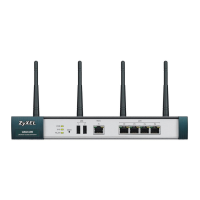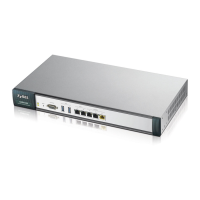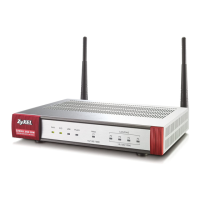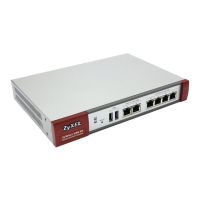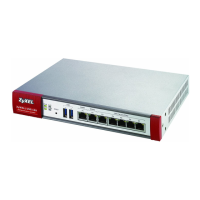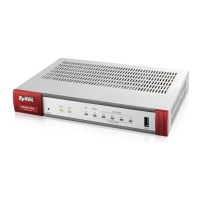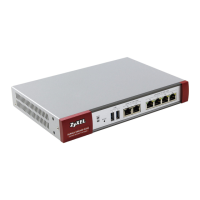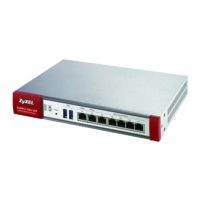Do you have a question about the ZyXEL Communications UAG2100 and is the answer not in the manual?
A general overview of the UAG and its capabilities, highlighting its integrated functionality.
Describes the default network configurations for zones, interfaces, and ports.
Explains the different ways to manage the UAG, including the Web Configurator and CLI.
Details on how to access and use the Web Configurator for UAG setup and configuration.
Step-by-step guide on accessing the UAG's Web Configurator via a browser.
Describes the main sections of the Web Configurator interface: title bar, navigation panel, and main window.
Explains the icons and functions available in the title bar of the Web Configurator.
How to find configuration settings that reference specific objects within the UAG.
Explains how to use the navigation panel to access various configuration and status screens.
Describes the screens available in the Monitor menu for checking status and statistics.
Describes the screens available in the Configuration menu for setting up features.
Explains how to interact with tables and lists in the Web Configurator for data management.
Instructions on how to properly shut down the UAG device to prevent firmware corruption.
Provides instructions and details for mounting the UAG on a wall.
Introduces the components and indicators on the UAG's front panel.
Describes the functionality of the 1000Base-T Ethernet ports.
Explains the purpose and usage of the USB 2.0 ports for system logs and kernel saving.
Describes the status and meaning of the front panel LEDs.
Shows the layout and components of the UAG's rear panel, including console port and power switch.
Details on connecting and using the console port for command-line interface access.
Outlines the process of setting up and deploying an external statement printer with the UAG.
Instructions for physically connecting the printer to the UAG.
Steps to configure the UAG's internet connection via a broadband modem or router.
How to configure the UAG to monitor and manage the connected printer's status.
Guides on enabling web authentication for network access control.
Instructions for creating guest accounts for free internet access during specified periods.
Overview of the wizard that guides initial UAG setup for internet connection and service activation.
Configuration steps for the WAN interface, including encapsulation and IP address assignment.
Details on configuring Ethernet-based Internet access settings.
Steps for configuring PPPoE connections for Internet access, including ISP parameters.
Steps for configuring PPTP connections for Internet access, including ISP parameters.
The final step of the Internet access setup wizard, reviewing configured settings.
Instructions for registering the UAG device online to activate service subscriptions.
An overview of quick setup wizards for configuring internet connection settings.
Selecting the Ethernet interface for WAN configuration.
Choosing the encapsulation type (Ethernet, PPPoE, PPTP) for the WAN connection.
Setting up IP address assignment (fixed or dynamic) for the WAN interface.
Configuring ISP account details and WAN connection parameters.
Introduction to the Dashboard screen for checking UAG status and system information.
Outlines the functionalities accessible via the Dashboard, including system status and resource usage.
Describes the main Dashboard screen, its widgets, and customization options.
Outlines the functionalities accessible via the Dashboard, including system status and resource usage.
Describes the main Dashboard screen, its widgets, and customization options.
Displays a chart of the UAG's recent CPU usage over time.
Displays a chart of the UAG's recent memory (RAM) usage over time.
Displays a chart of the UAG's recent traffic session usage.
Shows IP addresses assigned to DHCP clients and reserved for specific MAC addresses.
Lists users currently logged into the UAG.
Introduction to the Monitor screens for checking status and statistics information.
Lists the types of status and statistics information available in the Monitor section.
Displays packet statistics for each Gigabit Ethernet port.
Shows a line graph of packet statistics for each physical port.
Lists all UAG interfaces and their packet statistics.
Provides basic information about traffic statistics, including visited websites and protocols.
Displays information about all established sessions for debugging or statistical analysis.
Shows the status of the UAG’s Dynamic DNS (DDNS) domain names.
Lists devices with IP/MAC binding enabled and active sessions.
Lists users currently logged into the UAG.
Shows NAT port mapping rules created by UPnP.
Displays information about a connected USB storage device.
Lists dynamic guest user accounts stored in the UAG's local database.
Shows which Access Points (APs) are currently connected to the UAG.
Displays station statistics for a connected AP.
Shows statistics about wireless radio transmitters in connected APs.
Displays detailed information about a selected radio's SSIDs, traffic, and clients.
Shows statistics for associated stations (wireless clients).
Displays information about connected statement printers.
Shows the status of active users using VPN 1-1 mapping rules.
Displays statistics for each of the VPN 1-1 mapping rules.
Accesses and displays system log messages and debugging information.
Views current wireless Access Point (AP) log messages.
Views dynamic guest account log messages.
Introduction to registering the UAG and managing its service subscriptions.
Lists tasks related to UAG registration with myZyXEL.com and service management.
Provides background information on myZyXEL.com and available subscription services.
The screen used for registering the UAG with myZyXEL.com.
Introduction to configuring how the UAG manages Access Points (APs) connected to its wireless network.
Outlines tasks related to AP management and controller settings.
Configures how the UAG allows new APs to connect to the network.
Manages all Access Points (APs) connected to the UAG.
Introduction to configuring UAG interfaces and creating interfaces on top of others.
Lists tasks related to configuring various interface types: Port Role, Ethernet, PPP, VLAN, Bridge, Virtual.
Explains general interface characteristics applicable to different interface types.
Describes different types of interfaces (port groups, Ethernet, VLAN, Bridge, PPP, Virtual, Trunk) in the UAG.
Sets UAG's flexible ports as part of LAN1 or LAN2 interfaces, creating hardware connections.
Lists all Ethernet and virtual interfaces created on top of Ethernet interfaces.
Configures IP address assignment, parameters, DHCP settings, and MAC settings for Ethernet interfaces.
Explains how to find configuration settings that reference specific objects.
Adds DHCP extended options when configuring a DHCPv4 server.
Explains how to use PPPoE/PPTP interfaces to connect to an ISP.
Lists every PPPoE/PPTP interface configured on the UAG.
Configures PPPoE or PPTP interfaces, requiring ISP account setup first.
Divides a physical network into multiple logical networks using VLANs.
Explains how VLAN interfaces function and interact within the UAG.
Lists VLAN and virtual interfaces created on top of VLAN interfaces.
Introduces bridge interfaces and explains the screens for configuring them.
Explains how bridge interfaces create software bridges between network segments.
Lists every bridge interface and virtual interface created on top of bridge interfaces.
Configures IP address, bandwidth, DHCP, and connectivity for bridge interfaces.
Explains how virtual interfaces are used to route packets within the UAG.
Configures IP address assignment and interface parameters for virtual interfaces.
Provides detailed information about UAG interfaces, including IP addressing and routing.
Explains how to use trunks for WAN load balancing to increase throughput and reliability.
Outlines tasks related to trunk configuration, link sticking, and load balancing algorithms.
Provides information on adding WAN interfaces to trunks and policy routing for traffic distribution.
Describes algorithms (Least Load First, Weighted Round Robin, Spillover) for interface traffic distribution.
Explains the Least Load First load balancing algorithm based on bandwidth utilization.
Describes the Weighted Round Robin load balancing algorithm considering interface weights.
Explains the spillover load balancing algorithm, sending traffic to the next interface when load limits are reached.
Lists configured trunks and the load balancing algorithm each is set to use.
Steps to create or edit a user-defined WAN trunk, including member interfaces and algorithms.
Configures load balancing algorithms and bandwidth allocations for the system default trunk.
Introduction to policy and static routes for overriding default routing behavior.
Lists tasks related to configuring policy routes and static routes.
Explains policy routing, static routes, and DiffServ concepts.
Explains policy routing as a mechanism to override default routing behavior.
Describes using static routes to send data to devices not reachable via the default gateway.
Compares policy routes to static routes, highlighting flexibility and priority.
Explains Quality of Service (QoS) using DiffServ for prioritizing traffic flows.
Explains DSCP marking and its effect on traffic forwarding using DiffServ.
Screen for viewing and configuring policy routes based on matching criteria and actions.
Configures or edits a policy route, defining criteria and actions for traffic routing.
Displays and configures static routes to propagate routing information to other routers.
Configures or edits static routes, specifying destination, subnet mask, gateway, and interface.
Explains Network Address Translation (NAT) and Source NAT (SNAT) for IP address translation.
Describes Assured Forwarding (AF) behavior groups for DiffServ, including drop precedence.
Explains how to set up zones for network security and policy configuration.
Lists tasks related to managing UAG zones, including adding, editing, and removing.
Discusses how zones affect different types of traffic: intra-zone, inter-zone, and extra-zone.
Explains how zones divide traffic into intra-zone, inter-zone, and extra-zone traffic.
Provides a summary of all zones and allows adding, editing, and removing zones.
Allows adding or editing a zone, including assigning member interfaces.
Introduction to Dynamic DNS (DDNS) services for using domain names with dynamic IP addresses.
Lists tasks for viewing and adding DDNS domain names and their configurations.
Provides information on DNS mapping and required dynamic DNS accounts.
Summarizes all DDNS domain names and their configurations, allowing add, edit, delete.
Adds or edits DDNS domain name configurations.
Introduction to Network Address Translation (NAT) for making private network computers available externally.
Lists tasks for viewing and managing NAT rules and their configurations.
Defines NAT and its alternative names: virtual server, port forwarding, or port translation.
Refers to technical background information related to NAT screens.
Provides a summary of all NAT rules and their configurations.
Creates new NAT rules or edits existing ones.
Provides detailed information about NAT functionality on the UAG.
Explains how NAT loopback allows WAN users to access internal services via original IP.
Allows authenticated users to access the Internet or servers using a unique public IP address.
Outlines tasks for enabling and configuring VPN 1-1 mapping rules.
Discusses VPN 1-1 Mapping, Firewall, and Policy Route interactions.
Explains how VPN 1-1 mapping, firewall, and policy routes interact for packet flow.
Summarizes all VPN 1-1 mapping rules and their configurations.
Configures or edits VPN 1-1 mapping rules.
Configures pool profiles defining public IP addresses assigned to matched users.
Forwards the client's HTTP request to a web proxy server.
Lists tasks for displaying and editing HTTP redirect rules.
Explains the functionality of a Web Proxy Server.
Describes how a proxy server assists clients in accessing resources and provides security.
Explains the packet flow for HTTP redirect traffic, including firewall and policy route interactions.
Configures redirection of HTTP requests to a proxy server.
Configures or edits an HTTP redirect rule.
Forwards authenticated client SMTP messages to an SMTP server for delivery.
Lists tasks for displaying and editing SMTP redirect rules.
Explains the Simple Mail Transfer Protocol (SMTP) and its usage.
Describes the Simple Mail Transfer Protocol (SMTP) as the Internet's message transport standard.
Explains packet flow for SMTP redirect traffic, including firewall and policy route interactions.
Configures redirection of SMTP messages to an SMTP server.
Configures or edits an SMTP redirect rule.
Explains how Application Layer Gateway (ALG) allows applications to operate through UAG NAT.
Lists tasks for setting up FTP ALG settings.
Explains Application Layer Gateway (ALG), NAT, and Firewall functionality.
Describes how ALG functions with NAT and Firewall to support un-friendly applications.
Explains the FTP ALG functionality for allowing TCP packets with specified port destinations.
Discusses ALG traffic management through interface trunks and failover scenarios.
Enables and configures ALG settings, including FTP ALG settings.
Introduction to UPnP and NAT-PMP for device discovery and seamless network connection.
Identifies UPnP hardware and explains its functionality.
Automates UPnP NAT traversal for application operation through NAT.
Highlights security considerations and potential issues with UPnP.
Enables UPnP and NAT-PMP on the UAG.
Provides examples and technical details for using UPnP.
Demonstrates using the UPnP feature in Windows XP.
Guides on automatically discovering UPnP devices on the network.
Ensures intended devices use privileged IP addresses by binding IP to MAC addresses.
Outlines tasks for binding IP addresses to MAC addresses and configuring exempt lists.
Explains that IP/MAC bindings are based on the UAG’s dynamic and static DHCP entries.
Explains the role of DHCP in managing IP/MAC address bindings.
Lists IP to MAC address bindings for devices connected to each supported interface.
Configures an interface's IP to MAC address binding settings.
Configures static IP to MAC address bindings for devices.
Configures ranges of IP addresses to which the UAG does not apply IP/MAC binding.
Prevents connected devices from communicating within the UAG's local network, except for devices on the white list.
Outlines tasks for enabling layer-2 isolation and configuring the white list.
Enables layer-2 isolation on the UAG and specific internal interfaces.
Blocks IP addresses not in the white list from communicating with other devices.
Creates or edits rules in the white list to allow specific IP addresses access.
Allows computers to access the Internet without changing network settings, even across subnets.
Outlines tasks for enabling IPnP on the UAG and its internal interfaces.
Enables IPnP on the UAG and specific internal interfaces.
Intercepts network traffic until user authentication via a designated login web page.
Outlines tasks for creating and managing web authentication policies.
Discusses forced user authentication for HTTP traffic.
Automatically displays the login screen for unauthenticated users accessing HTTP traffic.
Refers to an example of user-aware access control configuration.
Displays web portal settings and web authentication policies configured on the UAG.
Configures an authentication policy, specifying user, source, destination, schedule, and authentication.
Demonstrates configuring security settings for specific users or groups authenticated via RADIUS.
Guides on setting up user accounts in the RADIUS server or locally.
Guides on setting up user groups and assigning users to them.
Sets up user authentication using a RADIUS server and authentication methods.
Defines web site addresses that users can access without logging in.
Adds or edits walled garden URL entries for the login screen.
Sets the UAG to display an advertisement web page as the first page upon user connection.
Enables or disables the firewall, manages asymmetrical routes, and configures firewall rules.
Outlines tasks for firewall configuration and session control.
Explains Stateful Inspection, Zones, Default Firewall Behavior, To-Device Rules, and Global Firewall Rules.
Restricts access by screening data packets against defined access rules and inspecting sessions.
Groups interfaces to configure network security and policies.
Describes the default behavior for traffic based on packet direction (From Zone to To Zone).
Rules applying to traffic directed to the UAG itself, controlling access and management.
Rules applying to interfaces not included in a zone, affecting traffic flow.
Explains how the UAG checks traffic against firewall rules based on various criteria.
Allows specifying users or user groups in firewall rules for granular access control.
Limits the number of concurrent NAT/firewall sessions a client can use.
Refers to section 25.4 for examples of creating firewall rules for user-aware access control.
The main screen for enabling/disabling the firewall, asymmetrical routes, and managing rules.
Discusses handling asymmetrical route topology and potential connection resets.
Guides on enabling firewall, routes, session limits, and displaying configured rules.
Configures or edits firewall rules, specifying criteria like zone, user, source, and action.
Limits the number of concurrent NAT/firewall sessions a client can use.
Configures session limit rules for specific users, addresses, or both.
Provides an example of creating a firewall rule to block specific traffic.
Introduction to setting up billing profiles, accounting methods, discounts, and payment services.
Lists tasks for configuring general billing settings, billing profiles, discounts, and payment services.
Explains Accumulation Accounting and Time-to-finish Accounting methods.
Allows multiple re-logins until allocated time is used or account expires.
Suitable for one-time logins; tracks usage time allocated.
Configures general billing settings like accounting method, currency, and SSID profiles.
Configures billing profiles defining maximum Internet access time and charges per unit.
Allows automatic creation of dynamic guest accounts and printing account information.
Creates new billing profiles or edits existing ones.
Configures custom discount pricing plans for longer usage periods.
Creates or edits discount levels for pricing.
Configures credit card transaction services for authorizing and processing payments.
Customizes the online payment service pages displayed after user payment.
Describes creating dynamic guest accounts and printing account information via printers.
Outlines tasks for configuring printer lists and customizing account printouts.
Configures the printer list and enables printer management and status monitoring.
Customizes the format of the account printout.
Explains the types of reports that can be printed using the SP300E, like account summaries.
Lists key combinations required to print specific reports on the SP350E.
Details the format and content of the daily account report.
Details the format and content of the monthly account report.
Provides notes on account report limitations, such as entry limits and calculation methods.
Shows current system information such as the host name and WAN IP address.
Allows users to browse the Internet free of charge for a specified period of time.
Outlines turning on the free time feature to allow guest accounts for internet surfing.
Enables and configures the free time settings for guest access.
Supports sending short text messages to mobile devices using a SMS gateway.
Outlines turning on the SMS service for sending guest account information.
Enables SMS service for sending dynamic guest account information in text messages.
Manages service usage, protocols, and applies traffic prioritization for performance.
Outlines controlling bandwidth for services passing through the UAG.
Explains TCP/UDP traffic control and policy routes for other traffic types.
Discusses Quality of Service (QoS) using DiffServ for prioritizing traffic flows.
Explains connection direction and packet flow for bandwidth management.
Limits application outbound or inbound bandwidth to ensure fair usage.
Explains how UAG prioritizes traffic and allocates bandwidth.
Allows applications to borrow any unused bandwidth on the outgoing interface.
Shows how bandwidth management behaves with various settings.
Explains how configured rates affect available bandwidth.
Demonstrates how priority affects bandwidth allocation when rates exceed available bandwidth.
Explains the impact of maximize bandwidth usage on bandwidth distribution.
Discusses effects of over-allocating bandwidth with different priorities.
Refers to DSCP Marking and Per-Hop Behavior for more details.
Controls bandwidth allocation for TCP and UDP traffic using various criteria.
Creates or edits bandwidth management policies.
Describes setting up user accounts, groups, and settings for UAG traffic routing control.
Lists tasks for managing user accounts, groups, and user settings.
Explains User Account types (admin, access, ext-user, guest-manager) and their attributes.
Defines user privileges for logged-in users, used in firewall rules and access control.
Lists the different types of user accounts supported by the UAG.
Describes accounts authenticated by an external server (e.g., RADIUS).
Describes accounts that group users by RADIUS server group membership attributes.
Describes dynamically created guest accounts with time limits and potential expiration.
Accounts for testing internet connection without time limits or charges.
Allows creating rules for multiple user accounts simultaneously.
Requires users to log in to restrict network services based on user identity.
Provides information on users who use an external authentication server for login.
Provides a summary of all user accounts.
Creates or edits user accounts, specifying user type and settings.
Specifies rules and limitations for creating user names.
Provides a summary of all user groups.
Creates or edits user groups, allowing members to be added or removed.
Controls default settings, login, lockout, and other user-specific settings.
Controls default authentication timeout settings for new user accounts.
Sets default authentication timeouts for user accounts.
Sets default authentication timeout settings for user account types.
Demonstrates user-aware login configuration for restricting network services.
Shows how to configure preset profiles for Access Points (APs) connected to the UAG.
Lists tasks for creating radio configurations and SSID profiles.
Defines terms and concepts relevant to wireless profiles: Radio, SSID, Security, MAC Filtering.
Describes different types of wireless profiles: Radio, SSID, Security, MAC Filtering.
Defines SSID as the name identifying a wireless network for client connections.
Creates radio configurations for APs, allowing settings for transmitters.
Creates or edits radio profiles for APs, configuring band, mode, channel, and advanced settings.
Configures SSID profiles, security lists, and MAC filter lists for wireless networks.
Creates and manages SSID configurations for APs, defining network names visible to clients.
Creates or edits SSID profiles, associating security and MAC filtering settings.
Manages wireless security configurations, including encryption methods for SSIDs.
Creates or edits security profiles, configuring security modes like WEP, WPA, WPA2.
Creates and manages MAC security configurations to control wireless client access.
Creates or edits MAC filtering profiles to allow or deny client connections based on MAC addresses.
Explains how address objects and groups represent IP addresses for routing and firewall rules.
Lists tasks for managing addresses and address groups.
Explains the usage of address objects and groups in various UAG features.
Describes address group composition and that member order is not important.
Provides a summary of all addresses, detailing types like HOST, RANGE, SUBNET.
Creates or edits address objects, defining name, type, and IP details.
Summarizes all address groups, allowing viewing and management.
Creates or edits address groups, allowing members to be added or removed.
Explains using service objects to define TCP, UDP, and ICMP applications.
Lists tasks for viewing and configuring services and service groups.
Explains IP protocols: TCP, UDP, and ICMP.
Details the TCP, UDP, and ICMP protocols used for data exchange.
Defines service objects and groups used in policy routes and firewall rules.
Provides a summary of all services and their definitions.
Creates or edits service objects, specifying protocol, port, and type.
Summarizes all service groups, allowing adding, editing, and removing.
Creates or edits service groups, allowing members (services/groups) to be added or removed.
Explains using schedules for policy routes and firewall rules.
Lists tasks for managing schedules, including creating one-time and recurring schedules.
Describes one-time schedules (effective once) and recurring schedules (repeat daily).
Schedules effective only once, based on specific start/stop dates and times.
Schedules that repeat daily on selected days of the week.
Refers to section 40.4 for information about the UAG's current date and time.
Lists all schedules configured in the UAG.
Creates or edits one-time schedules, specifying name, start/stop date and time.
Creates or edits recurring schedules, specifying start/stop time and effective weekdays.
Explains using AAA (Authentication, Authorization, Accounting) servers for network access control.
Describes RADIUS authentication for user authentication using an external server.
Outlines configuring the default external RADIUS server for user authentication.
Lists the types of authentication servers supported by the UAG.
Lists supported authentication server types: Local user database and RADIUS.
Explains the RADIUS protocol for authenticating users via a central server.
Manages the list of RADIUS servers the UAG can use for user authentication.
Creates or edits RADIUS server entries, configuring address, port, and key.
Sets how the UAG authenticates clients using local database or external servers.
Lists tasks for creating and managing authentication method objects.
Recommends configuring AAA server objects before authentication method objects.
Creates and manages authentication method objects, linking them to AAA servers.
Creates an authentication method object, specifying name and server list.
Explains using certificates for user authentication based on public-private key pairs.
Outlines tasks for managing My Certificates and Trusted Certificates.
Explains public-key cryptography, key pairs, certificates, and digital signatures.
Lists the benefits of using certificates, such as secure key distribution.
Describes generating self-signed certificates where the UAG acts as the Certification Authority.
Mentions the unique self-signed certificate generated upon first use.
Lists supported certificate file formats like X.509 (Binary/PEM) and PKCS#7 (Binary/PEM).
Describes how to verify a certificate's fingerprint using MD5 or SHA1 algorithms.
Provides a summary list of certificates and certification requests stored on the UAG.
Creates self-signed certificates, enrolls with CAs, or generates certification requests.
Views detailed certificate information and changes the certificate's name.
Saves existing certificates (CA-signed or PKCS#12) to the UAG.
Displays a summary list of certificates that the UAG is set to accept as trusted.
Views detailed certificate info, changes name, and sets trust verification for certificates.
Manages Internet Service Provider (ISP) account information for PPPoE/PPTP interfaces.
Refers to Section 10.4 for information about PPPoE/PPTP interfaces.
Outlines tasks for creating and managing ISP accounts in the UAG.
Provides a summary of ISP accounts in the UAG.
Adds or edits ISP account information, including protocol, authentication, and user name.
Introduction to configuring general UAG system settings.
Lists tasks for configuring host name, USB storage, date/time, console speed, DNS, WWW, SSH, Telnet, FTP, SNMP, Language.
Configures a unique name for the UAG on the network.
Configures settings for connected USB devices for storing system logs and diagnostic information.
Configures the UAG’s date, time, and time zone for accurate scheduling and logging.
Lists pre-defined NTP time servers for time synchronization.
Synchronizes UAG date and time with a specified time server.
Sets the console port speed for terminal emulation programs.
Explains Domain Name System (DNS) for mapping domain names to IP addresses.
Explains how UAG obtains DNS server addresses: from ISP, public DNS, or manual entry.
Configures UAG DNS settings for resolving domain names for features like DDNS.
Maps Fully-Qualified Domain Names (FQDN) to IP addresses.
Maps IP addresses to domain names (reverse lookup).
Adds address or PTR records for UAG or other devices.
Specifies DNS server IP addresses to resolve domain zones.
Adds a domain zone forwarder record to the DNS settings.
Specifies the host responsible for mail delivery for a particular domain.
Adds an MX record to the table.
Adds a service control rule to manage DNS queries.
Discusses secure (HTTPS) and insecure (HTTP) management of the UAG.
Explains conditions under which services cannot access the UAG.
Configures idle timeouts for administrator sessions and reauthentication times.
Sets up secure HTTP or HTTPS access to the UAG, specifying zones and IP addresses.
Specifies zones and IP addresses allowed for HTTP or HTTPS access to the UAG.
Adds or edits service control rules for WWW, SSH, Telnet, FTP, or SNMP access.
Customizes the Web Configurator login and access pages, including logo and colors.
Provides examples of accessing the UAG via HTTPS, including browser warnings.
Explains how to avoid browser warnings related to certificates by importing them.
Describes the Web Configurator login screen appearance after certificate acceptance.
Guides on enrolling and importing SSL client certificates required for HTTPS access.
Instructions for installing a Certificate Authority's (CA) trusted certificate.
Instructions for installing personal certificates obtained from a CA.
Explains how to securely access the UAG's command line interface using SSH.
Describes the process of establishing a secure SSH connection between hosts.
Details SSH versions, authentication methods, and encryption supported by the UAG.
Lists prerequisites for using SSH, including installing an SSH client program.
Specifies zones and IP addresses allowed for SSH management access.
Provides examples of remote access to the UAG using SSH client programs.
Guides accessing the UAG via Secure Shell Client in Windows.
Guides accessing the UAG via OpenSSH client in Linux.
Explains using Telnet for remote command-line interface access.
Specifies zones and IP addresses allowed for Telnet management access.
Explains uploading/downloading firmware and configuration files using FTP.
Specifies zones and IP addresses allowed for FTP access.
Describes SNMP agent functionality for network device management.
Lists supported MIBs (Management Information Bases) for collecting statistical data.
Explains SNMP traps sent to the manager upon specific network events.
Configures SNMP settings, including zones and IP addresses for access.
Selects the display language for the UAG’s Web Configurator screens.
Introduction to configuring daily reporting and system log settings.
Lists tasks for configuring email daily reports and log settings.
Configures sending system statistics via email daily.
Controls log messages and alerts, including email, storage, and remote server settings.
Provides a summary of configured log settings.
Controls detailed settings for the system log, including categories and email options.
Configures detailed settings for saving logs to a connected USB storage device.
Controls detailed settings for logs stored on remote servers (syslog).
Edits information included in system logs, USB storage, and email profiles by category.
Defines configuration files and shell scripts for managing UAG settings.
Lists tasks for managing configuration files, firmware, and shell scripts.
Explains configuration files and shell scripts, including their syntax and application.
Describes how configuration files and shell scripts are applied and their differences.
Explains how to add comments to configuration files or shell scripts using '#' or '!'.
Stores, runs, names, downloads, and uploads configuration files.
Describes how the UAG handles configuration files during restarts.
Checks current firmware version and uploads new firmware to the UAG.
Stores, names, downloads, uploads, and runs shell script files.
Describes labels for managing shell script files: Rename, Remove, Download, Copy, Apply.
Introduction to using diagnostic screens for troubleshooting network issues.
Lists tasks for generating diagnostic files, capturing packets, and managing logs.
Generates a file containing UAG configuration and diagnostic information for customer support.
Lists diagnostic files collected and stored on a USB storage device.
Captures network traffic going through the UAG’s interfaces for analysis.
Lists stored packet capture files, allowing download and deletion.
Saves process core dumps to a USB device if a process terminates abnormally (crashes).
Lists stored core dump files, allowing download and deletion.
Lists system log files stored on a connected USB storage device.
Provides a picture of how the UAG determines packet forwarding and IP address changes.
Lists tasks for viewing routing flow and SNAT function settings.
Views the current routing flow and links to specific routing settings.
Views the overall source NAT (SNAT) flow and each SNAT function's settings.
Restarts the device, for example, if it behaves erratically.
Explains that shutdown writes cached data and stops system processes.
Allows remote users to restart the device via the Web Configurator.
Shuts down the device safely before disconnecting power.
Explains that shutdown writes cached data to local storage and stops system processes.
Provides a button to shut down the UAG safely.
Resets the UAG to factory-default settings if access is lost or password forgotten.
Suggests searching www.zyxel.com for support information and troubleshooting suggestions.
Lists information needed when contacting customer support: model, serial, warranty, date, problem description.
Copyright notice for the publication, stating rights reserved by ZyXEL Communications Corporation.
ZyXEL's liability disclaimer for application or use of described products or software.
Lists regulatory certifications like FCC Interference Statement and Industry Canada Statement.
FCC statement regarding device compliance with Part 15 rules and potential interference.
FCC statement regarding radiation exposure limits for the equipment.
Industry Canada compliance statement for the device.
General notices regarding changes or modifications to the equipment.
Declaration for energy-related products conforming to EU Directive 2009/125/EC.
Provides a link to view the product's documentation and certifications online.
Lists national restrictions for EU countries and others regarding wireless LAN usage.
Provides a table of national codes used in regulatory information.
Lists important safety precautions for using the device, including electrical safety.
| Device Type | Unified Access Gateway |
|---|---|
| LAN Ports | 4 |
| VPN Support | Yes |
| Firewall | Yes |
| Power Supply | 12V DC |
| Storage Temperature | -20°C to 70°C |
| Humidity | 10% to 90% (non-condensing) |
| WAN Ports | 2 |
| Wireless Standards | 802.11 b/g/n |
| Interfaces | 2 WAN, 1 USB |
| Operating Temperature | 0°C to 40°C |
